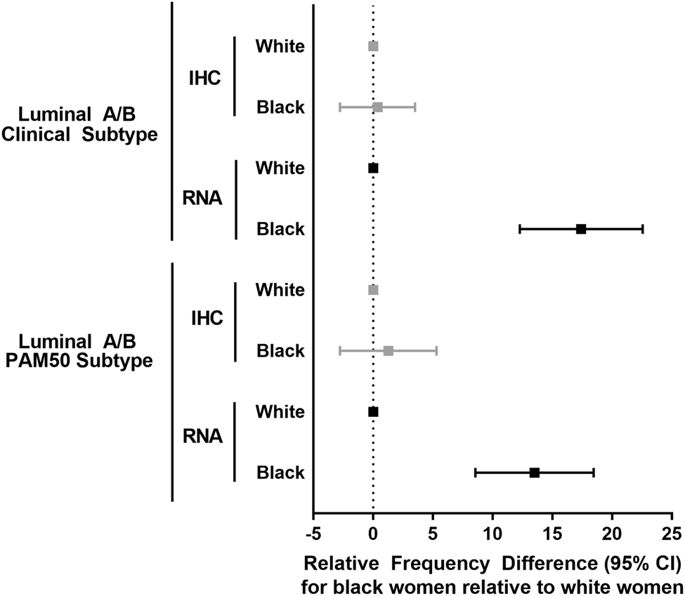npj Breast Cancer ( IF 6.5 ) Pub Date : 2018-06-25 , DOI: 10.1038/s41523-018-0067-5 Lindsay A. Williams , Ebonee N. Butler , Xuezheng Sun , Emma H. Allott , Stephanie M. Cohen , Ashley M. Fuller , Katherine A. Hoadley , Charles M. Perou , Joseph Geradts , Andrew F. Olshan , Melissa A. Troester

|
Mutations in tumor suppressor TP53 have been inconsistently linked to breast cancer risk factors and survival. Immunohistochemistry (IHC) staining, a primary clinical means of TP53 mutation determination, only detects mutations that facilitate protein accumulation (e.g., missense mutations). RNA-based pathway methods capture functional status and may aid in understanding the role of TP53 function in racial disparities of breast cancer. TP53 status was assessed among invasive breast cancer cases from the Carolina Breast Cancer Study (CBCS) (2008–2013) using IHC and an established RNA-based TP53 signature (CBCS and The Cancer Genome Atlas (TCGA)). Frequency of TP53 status (IHC, RNA-based) was estimated in association with tumor characteristics, PAM50 intrinsic subtype, age, and race using relative frequency differences (RFDs) and 95% confidence intervals (95% CI) as the measure of association. Approximately 60% of basal-like tumors were TP53 protein positive (IHC), while nearly 100% were TP53 mutant-like (RNA). Luminal A tumors had low frequency of TP53 positivity (IHC: 7.9%) and mutant-like status (RNA: 1.7%). Mutant-like TP53 (RNA) was strongly associated with age ≤50 years, high tumor grade, advanced stage of disease, large tumor size, and basal-like and HER2 intrinsic subtypes. Black race was strongly associated with TP53 mutant-like status (RNA) (RFD: 24.8%, 95% CI: 20.5, 29.0) even after adjusting for age, grade, stage (RFD: 11.3%; 95% CI: 7.6, 15.0). Associations were attenuated and non-significant when measured by IHC. IHC-based TP53 status is an insensitive measurement of TP53 functional status. RNA-based methods suggest a role for TP53 in tumor prognostic features and racial disparities.
中文翻译:

TP53蛋白水平,基于RNA的途径评估以及浸润性乳腺癌病例之间的种族
肿瘤抑制因子TP53中的突变与乳腺癌的危险因素和生存率不一致。免疫组织化学(IHC)染色是TP53突变测定的主要临床手段,仅检测有助于蛋白质积累的突变(例如,错义突变)。基于RNA的途径方法可捕获功能状态,并可能有助于了解TP53功能在乳腺癌的种族差异中的作用。TP53使用IHC和已建立的基于RNA的TP53标记(CBCS和《癌症基因组图谱》(TCGA)),对卡罗莱纳州乳腺癌研究(CBCS)(2008-2013)的浸润性乳腺癌病例进行了评估。使用相对频率差异(RFD)和95%置信区间(95%CI)作为关联度量,估计TP53状态的频率(IHC,基于RNA)与肿瘤特征,PAM50固有亚型,年龄和种族相关。约60%的基底样肿瘤为TP53蛋白阳性(IHC),而近100%的基底样肿瘤为TP53突变样(RNA)。Luminal A肿瘤的TP53阳性频率较低(IHC:7.9%),且具有突变样状态(RNA:1.7%)。突变体样TP53(RNA)与年龄≤50岁,高肿瘤分级,疾病晚期,大肿瘤大小以及基底样和HER2内在亚型密切相关。)(RFD:24.8%,95%CI:20.5,29.0),即使在调整了年龄,等级和阶段后(RFD:11.3%; 95%CI:7.6,15.0)。通过IHC测量时,关联性减弱且不显着。基于IHC的TP53状态是对TP53功能状态的不敏感度量。基于RNA的方法表明TP53在肿瘤的预后特征和种族差异中起作用。





















































 京公网安备 11010802027423号
京公网安备 11010802027423号